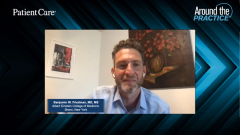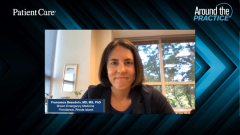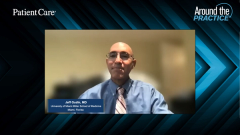
Substance Abuse When Selecting Therapy for Acute Pain
Pain experts discuss the issue of substance abuse when selecting therapy for acute pain.
Episodes in this series

Benjamin W. Friedman, MD, MS: There’s one question that I’d like to bring up regarding his history of recreational drug use in high school. It’s marijuana, but for the sake of discussion, we could also touch on a scenario where it’s more than marijuana. Does this impact treatment decisions at all, particularly if you come to the point where you’re thinking about prescribing opioids?
Francesca Beaudoin, MD, MS, PhD: You hit the nail on the head, Ben, that we want to know a little more about that. If we’re talking about occasional marijuana use in high school, it’s very different from somebody who’s used injection drugs before. What’s the nature of the recreational drug use? Do we think this person is at risk for opioid misuse and transition to an opioid use disorder if prescribed a short course of opioids? There are screening tools that we can use if we’re concerned, but getting some more granular information is important. Right now, everybody warrants a discussion of risks and benefits of opioids at the point of prescribing, so regardless of this person’s past history, that conversation needs to be had.
Paul Arnstein, RN, PhD, FAAN: I agree that doing a more in-depth assessment about the fact that he’s admitted to using recreational drugs in high school is important because there might be more there. We should look into not only the personal history, but also the family history, as well as the personal and family history of mental health disorders. With all the life changes that he’s been experiencing, is he experiencing depression or anxiety at this time? Those might drive some of our opioid use concerns.
Having those types of risk factors don’t exclude patients who need opioids from having them, but we approach opioids in terms of the selection of which one might be appropriate, how many pills we give the patient, the duration of therapy, and how we monitor those patients. All those things are factored into the mix when we’re looking at a risk-benefit ratio of adding opioids. If we can limit exposure to opioids, that’s the way to go.
Benjamin W. Friedman, MD, MS: I’d like to drill down on that point a little more because it comes up a lot in my daily practice among my colleagues and with my residents. There are some people nowadays who are opioid absolutists, who get to the point where they would say, “I’d never prescribe an opioid in this scenario.” Is there anybody who feels that there’s no way that this gentleman should get opioids? It’s a bit hypothetical because we don’t have the patient in front of us and we can’t interview them in detail, but does everybody agree that it’s very likely that opioids could have a role for a patient of this sort?
Jeff Gudin, MD: Ben, I’m glad you brought that up, because I’m in an academic environment where there’s such opiophobia. I could see a resident or a fellow tossing this guy without any opioids. Let’s say there’s a call to the bedside and the patient says, “I probably shouldn’t have, I was so bad. I’ve been to the ED [emergency department], and I took some of my wife’s Percocet I found in the cabinet, and it worked for me. Why can’t I just get some Percocet?” I’d treat that patient in the acute scenario a little differently from how I’d treat the patient who comes to the chronic pain clinic.
As my colleagues said, you do a good psychosocial background check. You try to get a feeling for this patient’s propensity to abuse a prescription drug. And you look down and you see this big, red, swollen, ugly looking toe, and you know it’s very painful. I’m from the old school. I’d probably dispense a small supply of opioid to this patient, only because it’s apparent that he’s suffering, if his risk factors told me that he’s never used an injection drug, he doesn’t have bad depression, bipolar, or psychiatric disease, and has no personal or family history of drug misuse. Go through some of those questions that are in the assessment tools that we ask patients. But clearly, I see the other side of this where there are some practitioners who wouldn’t give this patient an opioid.
Francesca Beaudoin, MD, MS, PhD: This reminds me of an anecdote of a patient I saw who had a return visit to the emergency department. The day before, he had had a snowblower accident and had 4 of his fingers amputated in a snowblower. When I saw him 1 day later, he was coming back with severe, uncontrolled pain. The initial triage nurse who saw him was worried about whether he was having some sort of complication. When I looked at what he had been discharged with for pain management, he left the emergency department with a prescription for 2 tablets of Percocet, not even 1 per finger. This was 24 hours later. I’m thinking this guy is so undermanaged in terms of pain because of this fear of prescribing. It’s this swinging pendulum. I’m with everybody on this call, that opioids have a role in pain management, and it’s about trying our best to figure out who they’re appropriate for. But for this case scenario, I’d certainly consider a short course of opioids.
Paul Arnstein, RN, PhD, FAAN: Jeff brought up that a person might get medication from the medicine cabinet from a spouse or other family member. But when you look at the last 10 years, opioid prescribing has gone down by 40% and opioid overdoses have gone up 4-fold. There’s a lot of concern that if you don’t prescribe them something and they’re at their wit’s end, they might go to the illicit market where it’s easier to get an opioid. They might order 2 Percocet tablets online or get it from an illicit source, and that Percocet or other oxycodone product could be counterfeit and laced with fentanyl, and they overdose. Part of the problem is that we need to look at the balance that undertreating or not treating pain appropriately may be contributing to some of the opioid use disorder or opioid overdose death crises we’re faced with.
Transcript edited for clarity
Newsletter
Enhance your clinical practice with the Patient Care newsletter, offering the latest evidence-based guidelines, diagnostic insights, and treatment strategies for primary care physicians.





























































































































































































































































































































